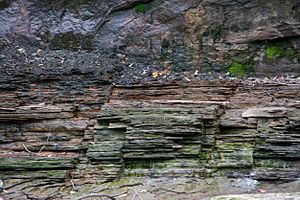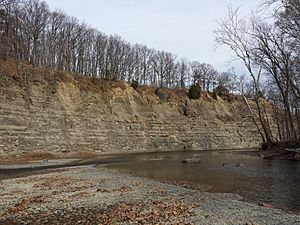Cleveland Shale facts for kids
Quick facts for kids Cleveland ShaleStratigraphic range: Famennian ~360–359Ma |
|
|---|---|

Cleveland Shale (below) and Berea Sandstone of the Bedford Formation at the Great Falls of Tinkers Creek near Bedford, Ohio
|
|
| Type | Formation |
| Unit of | Ohio Shale |
| Underlies | Bedford Shale |
| Overlies | Chagrin Shale |
| Lithology | |
| Primary | Shale |
| Other | Pyrite |
| Location | |
| Coordinates | 39°24′N 83°36′W / 39.4°N 83.6°W |
| Approximate paleocoordinates | 31°18′S 32°12′W / 31.3°S 32.2°W |
| Region | |
| Country | |
| Type section | |
| Named for | Cleveland, Ohio |
| Named by | John Strong Newberry |
| Year defined | 1870 |
The Cleveland Shale is a type of shale rock found in the eastern United States. It is also known as the Cleveland Member. This rock layer is part of a larger group of rocks called the Ohio Shale.
Contents
What is the Cleveland Shale?
The Cleveland Shale was first identified in 1870. It was named after the city of Cleveland, Ohio, where it was first studied. John Strong Newberry, a scientist who led the Ohio State Geological Survey, was the one who named it.
What Does It Look Like?
The Cleveland Shale is mostly made of minerals like chlorite, illite, pyrite, and quartz. When it's deep underground, it looks black, grayish-black, bluish-black, or brownish-black.
When you see it exposed to the air, it changes color to red, reddish-brown, or medium brown. If it's been exposed for a very long time, it can turn gray. This rock often breaks into thin, uneven pieces.
Layers of the Shale
The Cleveland Shale has a clear boundary with the rock layer below it, called the Chagrin Shale. Right at the very bottom of the Cleveland Shale, there's a thin, broken layer of pyrite. This pyrite layer isn't continuous because some of it was worn away by water long ago. In some places, this pyrite layer even has pieces of petrified wood and old fish bones!
Above this pyrite layer, the Cleveland Shale is generally a hard rock that is rich in organic material, like an oil shale. It has two main parts: a lower part and an upper part.
Lower Part
The lower part of the Cleveland Shale is a clay shale. It can be bluish, bluish-gray, or even olive-black to brownish-black. This section can be from a few inches to several feet thick. You might find thin layers of gray or brown siltstone, small lumps of pyrite, and layers of silica-rich limestone here.
Upper Part
The upper part of the Cleveland Shale is a black to brownish-black silty shale. It sometimes has thin layers of gray shale and siltstone. This upper part is much richer in petroleum and kerogen, which are important for fossil fuels. If you break open a fresh piece, it might even smell like crude oil! This part often has a wavy or "rippled" look, especially in northeast Ohio. It also contains many small, round nodules of phosphate and pyrite.
Where Can You Find It?
The Cleveland Shale is found in many parts of Ohio. It's especially common in northeast Ohio, where it varies in thickness. It can be as thin as 7 feet (2 meters) or as thick as 100 feet (30 meters). It's thickest around the Rocky River near Berea, Ohio.
You can also find the Cleveland Shale in east-central Kentucky. In Kentucky, it's usually between 41 and 50 feet (12 to 15 meters) thick. It's also present in West Virginia and southwest Virginia.
How Old Is It?
The Cleveland Shale is very old! It formed about 360 to 358.9 million years ago. This time period is known as the latest Devonian period, specifically the Famennian stage.
Amazing Fossils!
The Cleveland Shale is famous for its incredible fossils of ancient marine animals. Even though some parts of it don't have many fossils, there are special places where they are very well preserved.
- The pyrite layer at the bottom can contain petrified wood and fossilized fish bones.
- The upper part of the shale is known for its amazing fossils of ancient fish, especially Chondrichthyes (like early sharks), Conodonts, and Placodermi (armored fish).
- Some of the most famous giant armored fish, like Dunkleosteus terrelli, Gorgonichthys clarki, and Titanichthys, were discovered in the Cleveland Shale!
- This rock is considered a "konservatte-lagerstatten." This is a fancy way of saying it's a special place where fossils are preserved in amazing detail, often with complete bodies, soft tissues, and even stomach contents!
What Is It Used For?
Because the Cleveland Shale has a lot of organic material, it can form fossil fuels. Studies have shown that it can produce a good amount of petroleum (oil). It also contains small amounts of cannel coal and "true" coal.


